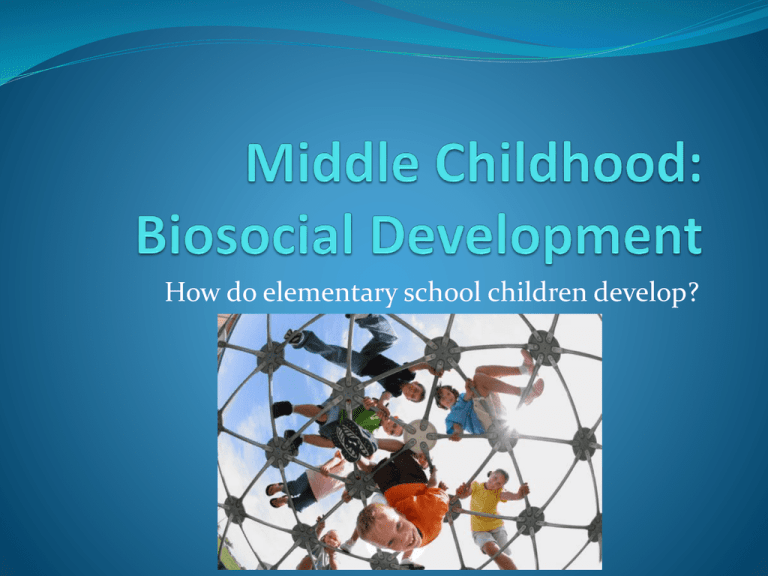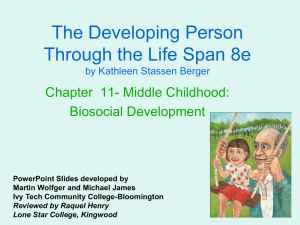How do elementary school children develop?
advertisement

How do elementary school children develop? Middle childhood: age 6 to 11 What is the healthiest period of life? Ages 6 - 11 Fatal diseases occur before age 6 or after age 11 Slow steady growth Stronger muscles Childhood health habits (e.g. oral health and exercise) can reduce stroke or heart attack in adulthood Main determinants of a healthy lifestyle is when parents, teachers, and peers have a healthy lifestyle What are major health problems in childhood? Obesity Asthma What is childhood obesity? BMI = Body Mass Index Weight to height Weight (in Kilograms) divided by the square of height (in meters). Overweight = BMI above 85th. Percentile Obesity = BMI above 95th. Percentile Increases asthma, high blood pressure, increased cholesterol (particularly LDL) BMI for Adults What factors affect obesity? Heredity (Over 200 genes affect weight) Parenting Not breast fed Family eating habits T.V. - food commercials Sodas No exercise Social influences Friends Snacks Do you remember? What is the healthiest period of life? What are the main health problems for children ages 6 – 11? What are the two main factors affecting obesity? What parenting influences affect obesity? What is asthma? Inflammation of the airways Wheezing, shortness of breath, coughing What causes asthma? Genes + environment Air pollution, pet dander, cigarette smoke, dust mites, mold, etc. How can you prevent asthma? Primary = Changes in the entire society Better ventilation, less pollution Secondary = Preventing attacks among high-risk children Exercise, less dust and smoke in the home Tertiary = Reducing the effects of current asthma Injections, inhalers, hypoallergenic materials (e.g. mattress covers), and filters (e.g. HEPA filters) Do you remember? What causes asthma? What are examples of the primary, secondary, and tertiary methods of treating asthma? Brain development Reaction time Faster reaction time from increased myelination E.g. “Think fast” when being thrown a ball Selective attention Focus on important items & ignore others E.g. Store P.A. system Automatization Easily performing routine actions without much conscious thought E.g. Driving to school How do we measure the mind? Aptitude tests Measures your potential for learning SAT test IQ Tests Original measurement of IQ (Intelligence Quotient) = Mental age divided by chronological age) X 100 Currently, test norms are used to determine the IQ Achievement tests Measures your knowledge (how much you have learned) Math test Are there multiple intelligences? Robert Sternberg Academic: IQ and achievement tests Creative Practical (street smarts – problem solving) Savant syndrome Do you remember? What is reaction time, selective attention, and automatization? What is the difference between aptitude tests and achievement tests? What are Sternberg’s three types of intelligences? What special needs do children have? ADHD = Attention-Deficit/Hyperactivity Disorder Inattentive, impulsive, difficulty concentrating Stimulants (e.g. Amphetamines like Ritalin or Strattera) have a reverse (calming) effect Bipolar disorder Extreme mood swings Learning disability Delay in a particular area – e.g. reading Not related to mental retardation No apparent physical disability Children with special needs (Cont.) Dyslexia Difficulty with reading One possible symptom - often reverses letters E.g. Unite = untie Thought to be result of speech & hearing difficulties Children with special needs (Cont.) Autism spectrum disorder Caused by genetic vulnerability & other factors Symptoms Extreme attention to details Inability to relate to other people (Poor social skills) Extreme self-absorption Impaired communication Delayed language, Poor social response, unusual repetitive play What laws are designed for children with special needs? PL94-142: Education of All Handicapped Children Act, 1975 Required an Individual Education Plan (IEP) for each child with special needs Educational goals, plans for achieving them, & periodic assessment PL 105-17: Individuals with Disabilities Education Act (IDEA), 1990 (Revised in later editions) Emphasizes parents’ rights in placement and IEP Special needs children must be placed in the least restrictive environment (LRE). LRE = The most general education situation where they can be expected to learn Do you remember? What is ADHD? What is the effect of stimulants on an ADHD child? What are some symptoms of autism spectrum disorder? What is an IEP for a special needs child?


